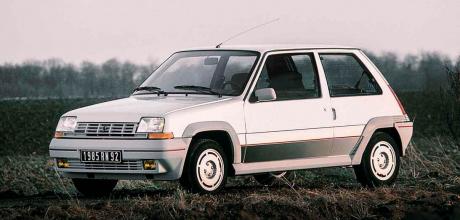Renault 5 GT Turbo

Forget the 205 GTI: this was France’s quickest 1980s hot hatch
THE MARKET / Buying Guide
If at any point in the past 40 years you’ve been in the market for a hot hatch, chances are there’s been a Renault fairly high on your list. The modern RS Meganes are some of the finest-handling cars of their generation, and the Clio Williams became a member of hot hatch royalty the second it went on sale. But the company’s hot hatch legacy was forged during the 1980s, thanks in no small part to the 5 GT Turbo.
Renault embraced turbocharging during the 1980s, playing off its motorsport success to invigorate its high-performance models. The legend began with the mid-engined 5 Turbo in 1980, a fire-breathing Group 4 rally car that really didn’t share much with the road car. It did, however, lay the groundwork for the front-engined 5 Gordini Turbo in 1982, powered by the unsophisticated pushrod eight-valve 1.4-litre Cléon engine. The turbocharger made for a very healthy 110bhp, so it was pretty quick, but there was no getting away from the 5’s ageing underpinnings and cramped, dated interior.
In 1984, the Renault ‘Supercinq’ solved the problem at a stroke. This was an all-new 5 based on the larger 11, wrapped up in a smart-looking Gandinistyled package – and it paved the way for the hot GT Turbo version that arrived in 1985.
Compared with the standard R5, the suspension was lowered by 38mm, and made substantially stiffer with an additional torsion rod at the rear, plus a pair of thicker anti-roll bars. An unpainted plastic bodykit, distinctive 13-inch alloy wheels and yellow foglights completed the visual transformation.
In truth, the carburetted engine hadn’t evolved all that much, although power was up to 115bhp, and a smaller Garrett T2 turbo improved the power delivery over the Gordini’s laggy response, while an air-to-air intercooler kept the output a bit more consistent. With early cars weighing 820kg, the GT Turbo was a seriously quick car: 0-60mph was dispatched in 7.5 seconds, and it would run out of steam at about 120mph. It wasn’t a one-trick pony, either. Get the car onto some twisty roads and it was entertaining and capable, yet very trustworthy on the limit.
In 1987 the Phase 2 model brought in some small but important changes. The turbocharger was watercooled, and a small underbonnet fan helped to prevent fuel evaporation – a problem that left the Phase 1 reluctant to re-start when warm. Ignition mapping tweaks brought the power up to 120bhp, while visual changes included a new grille, updated wheels and colour co-ordinating the bodykit. It was built until the end of 1991, with the run-out all-blue Raider edition making way for the Clio in 1992.
Throughout the 1990s and early 2000s, the GT Turbo was a favourite within the modifying scene. Cheap, fun and easy to tune to silly levels, many cars were mucked about with, crashed and abused. That means finding a tidy car has been difficult for years – far more so than an equivalent Golf or 205 GTI. Drive a good one today, though, and you’ll find it’s worth the effort. There’s a cracking chassis to enjoy, but it’s the addictive hit of boost from 2500rpm that really drives this ’80s nostalgia trip.
THE LOWDOWN
WHAT TO PAY
As with 205s, low-mileage original examples are a law unto themselves, with the best fetching £20,000-plus.
Expect to pay upwards of £10,000 for a well-maintained example with good history and all of its original parts intact. There are plenty of cars with good potential in the sub- £7000 category – perfect if you aren’t bothered by a few period modifications or something needing work.
WHAT TO LOOK OUT FOR
Beyond the obvious crash damage, check for rust around the windscreen, tailgate and under the plastic wheelarch trims.
Engines are very strong, but poor tuning can lead to various issues. Check for any signs of head gasket failure, as well as blue smoke, which could indicate a tired turbo. Interiors weren’t the best quality, and plastics have become even more brittle with age. Make sure it’s all in one piece, and that all the buttons and switches work. Thankfully, replacement fabric is now available for the seats.

